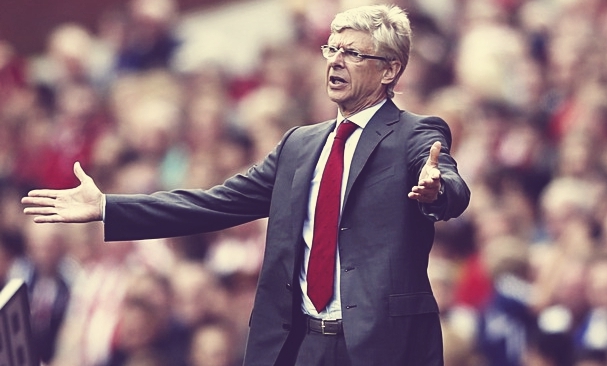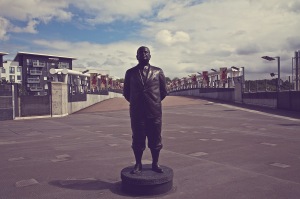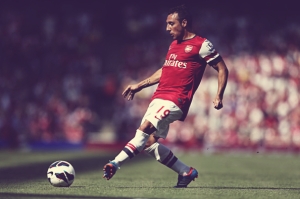To many, symmetry is the blissful ideal in football. Be it two direct wingers or two pacy wing-backs the game is often taken to the opposition on the flanks. In an era where the centre of the park is frequently packed with players on opposing teams competing for superiority the expanses out wide are opportune spaces for the flair and skills of wide men in the game to translate into genuinely decisive, match-winning contributions. With teams across the globe implementing different strategies, however, symmetrical simplicity is not always the optimal route to take.
Quick, wide forwards are all well and good when facing a team holding a rather naïve high line yet when faced with one of many parked buses these forwards, sometimes lacking the speed of mind to go with their fleetness of foot, can come unstuck. This scenario is one that Arsenal fans will no doubt be very familiar with. One only has to look at the start to this season to see where the problems lie. Arsène Wenger, who it must be said selected the team himself, was relatively unimpressed after the opener against Sunderland:
“The formula didn’t work with three strikers up front and we were not well balanced…we needed maybe one more creative player to be a bit more accurate in the final third. There was not a lot of space left to our strikers; everything had to be created from our midfield.”
Now, I should make it clear that the likes of Walcott and Gervinho certainly have a role to play in the squad. Their pace can be instrumental in matches, pinning back opposition fullbacks and creating more space for others in doing so. Provided the supply from midfield is in tune, their movement off the ball, spinning off their markers and making curved runs beyond defences can provide a very effective outlet. Theo’s technical ability and assurance on the ball, though still needing work, is improving apace helping him to retain the ball more frequently in tight situations and Gervinho’s unpredictable dribbling style can aid his beating of a man when one-on-one. Nonetheless, both would admit that their final balls could still do with some improvement which is why the issue of creativity looms large.
Playmakers are finding themselves on the flanks with increasing regularity in football and with this deployment the accuracy of pass in the final third and thus the quality of chances created is invariably enhanced. A higher proportion of quality chances naturally leads to a greater chance of a goal being scored so simple logic dictates that one should aim to maximise this. This precision of passing was certainly a factor Herbert Chapman, an iconic manager in the history of Arsenal Football Club, considered fundamental to his philosophy:
“Inside passing is more deadly, if less spectacular than the senseless policy of running along the lines and centring to just in front of the goalmouth, where the odds are nine to one on the defenders.”
Ever the innovator, Chapman’s views on wide play were in stark contrast to the rest of English football at the time and played a big part in his success during the 1920’s and 30’s. His use of Cliff Baston especially, though it must be noted he was not a playmaking type, was certainly different to that of other wingers of the age. In Chapman’s W-M (3-2-2-3) formation Bastin would stand in from his wing hoping to profit from the abundance of through-balls Alex James, an inside forward and creator-in-chief of the great Arsenal side of the 30’s, served up. His tremendous goalscoring record owed much to these factors and also to his subsequent cutting in from his already narrow position once the ball was received. On the rare occasions that a shot wasn’t on he could simply play a low pass inside, assisting the centre forward or winger cutting in from the opposite flank.
Football has changed since those days but, in truth, these rather basic aspects remain the same. A precise cutback or cute pass played on the edge of the box inside an opposition fullback is generally a far more successful tactic than an aimless ball played across the penalty area. Accurate inside passing is a key part of most wide playmakers’ repertoire, and is often lacking when direct options are used on both flanks. Completely replacing the hastily crossed balls oft-associated with the wide speed merchants of this world with more cerebral through-balls can make a team too predictable, though, so a variety of styles is a useful characteristic to possess in a team.
It’s certainly a trait Wenger has valued in his time on these shores, noticeably preferring either a more creative talent or tireless runner on one wing to balance a more attacking, direct option on the other. Think back to potent Wenger midfields past and you’ll see Parlour & Overmars, Pires & Ljungberg, Nasri & Walcott to name a few. More often than not, the balance has been there providing guile and pace in equal measure. Execution of pass is, of course, vital but that execution can be so more effective if the opposition have diverse threats to worry about.
Last season, after the early use of direct options on both wings, Wenger changed tact opting for more subtlety on one flank. The timing of the Africa Cup of Nations and squad options certainly played a part in this decision but one imagines Arsène wasn’t completely enamoured with our play at the time. Having dropped points over the busy Christmas and New Year schedule a different spark, an alternative source of ingenuity, was required. The calls for Alex Oxlade-Chamberlain to be given a chance were undoubtedly premature last year but had been deafening ever since his early signs of promise in the Carling Cup. Eventually these calls were met with the desired answer and ‘The Ox’ had finally garnered enough trust from Wenger to gain the opportunity to bring his own youthful exuberance to the party.
In addition to the pace that had already been present out wide before his arrival in the first team, Oxlade-Chamberlain brought vision. When deployed on the left he could cut inside onto his favoured right foot and, possessing the mindset of a midfielder, play slide-rule passes behind the opposition defence. In theory at least, his presence would allow for even more possession yet with the option to take on fullbacks on their outside or inside shoulder. A more varied and unpredictable threat was Wenger’s hope and it certainly did have its moments; Alex’s brace in the 7-1 demolition of Blackburn at the Emirates surely springs to the forefront of most fans’ thoughts. As with any youngster, however, his youth led to inconsistent performances and his naïvety lost possession during a period of the season where mistakes simply could not be afforded. Oxlade-Chamberlain’s time will come and interestingly he’s played more centrally this preseason just past. The added maturity in his game since the Euro’s is noticeable and as a result he’s likely to perform more consistently when he’s next given a chance.
The burden of bringing balance to the flanks was then passed onto Yossi Benayoun. Along with his experience he brought work-rate, ball retention and cunning to the left flank. After several games either on the bench or even out of the whole match day squad altogether Yossi was determined to make an impact. On the face of it, the fact that he provided goals at key times was merely a welcome bonus as he brought much more to the team. Whether it was snapping at the heels of the opposition with remarkable regularity, covering his fullback, holding a narrow position to enable midfield compactness when the flow of the game was not in our favour or dropping deeper to allow Walcott more licence to join the central striker, the balance Benayoun brought was instrumental in the overhaul of our North London rivals and securing a Champions League place for the 15th consecutive season.
Yossi’s stay in N5 was only a temporary one, though, so Wenger must now take a different route to provide the creative balance in the final third he values so dearly. The acquisition of Santi Cazorla is a mouth-watering one and given his previous roles for Villarreal and Málaga he’s a tempting wide option, especially in big games where the significance of possession and technical quality is arguably greater than the norm. As has already been mentioned it’s not uncommon to see ‘wide playmakers’ cut in from their designated flank and deliver crucial assists under slightly less attention than they would expect if played in a central role. With the number of alternative, fit central options already present within the squad and the returns of Tomáš Rosický and Jack Wilshere to consider (bringing valuable tenacity in addition to a further point of creativity) the selection of Santi on the wing, even in the ‘lesser games’, may not be so unrealistic.
Of course, there will be some that won’t want Arsène to remove him from the centre, where he has the whole freedom of the pitch in which to roam, prompting at will. Cazorla’s a player we haven’t really had since Cesc. His appreciation of space is excellent and his delicately-played through-balls will no doubt result in a glut of assists. His success, at least in terms of chances created, in the opening weeks of the season will add further fuel to the thinking that he’s already too crucial to be moved wide. If that is indeed the case then there’s always the possibility Rosický will be moved back to a similar role in which he started his Arsenal career. As previously stated, with his increased maturity, Oxlade-Chamberlain could well make the position his own or Wenger may even repeat last season’s experiment of varying success where he played Ramsey wide. The beauty of these options is that they’re players who are relatively comfortable in either role, wide or central, and would have the potential to interchange freely, disrupting the marking of the opposition as they do so.
In addition to these choices, there’s always the option of using Lukas Podolski wide left as Wenger did at the Britannia. It’s a position he’s very comfortable in having played in that role for the majority of his 101 caps for Germany. The wide left berth may have been Podolski’s starting position but he was far from confined to this location. It was noticeable, in preseason too, how often he drifted centrally, playing one-twos with Cazorla and driving into the box before unleashing a rocket from that cannon of a left foot. This can cause issues with regards to width if the player on the opposite wing is also regularly cutting inside and, again, if that player is a direct type there’s a worry that there will be too big a burden on the central creator. In recent years we have had a tendency to become over-reliant on certain individuals. Regardless of the option Arsène eventually lands on, and there’s still the chance (albeit a very small one) that a last minute move may be made in the transfer window to address this area, it is imperative that doesn’t become the case this season.
Some may prefer the symmetrical, direct twin threat on the flanks but it’s been shown repeatedly in the past, especially at Arsenal, that taking the asymmetrical route can aid one’s search for the perfect balance. The final pass and general creativity in the final third is currently lacking and though the gelling of our new players over time should see an improvement in cohesion going forward, adding an additional creator on one of the wings should enable us to carry a more varied and potent threat. Having similarly direct threats on the flanks is clipping our wings. Hopefully, with an extra dose of artistry, we can find a way to soar again.


